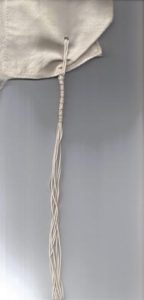Following on the heels of my last post, I explained that the Hebrew word SHA’ATNEZ used to describe the forbidden mixture of wool and linen is actually an idiom for prostitution.
Because of this, everyone assumes that such mixed material is completely forbidden by God.
But that’s not the case.
As I’ve already explained, God commanded His priests to wear some garments made out of the otherwise forbidden mixture of linen and wool.
“These are the garments they are to make: a breastpiece, an ephod,a robe, a woven tunic, a turban and a sash. They are to make these sacred garments for your brother Aaron and his sons, so they may serve me as priests. Have them use gold, and blue, purple and scarlet yarn, and fine linen.“-Exodus 28:4
If you’re wondering why it says “yarn” instead of “wool” in the above verse, understand that “wool” is a type of “yarn”.
And I’ve already mentioned that even the common Hebrew citizen was allowed to wear TZITZIT which was made out of this mixed combination of wool and linen.
Although one might argue that TZITZIT is more of a physical symbol rather than a garment that one wears.
So what are we to make of this?
Are we dealing with a contradiction here or not?
Is mixing linen and wool a forbidden mixture or not?
The answer is simple.
IT DEPENDS ON THE CIRCUMSTANCES AND WHO IS INVOLVED.
That’s right.
Whether a given union is clean or unclean or a certain mixture is acceptable or not is…
…NOT just based on what type of materials or objects are being used.
And don’t think, this gives you the freedom to simply go hog wild and interpret circumstances in a willy-nilly fashion in order to rationalize your behavior.
The Torah gives us enough information so that we can understand not only what to do but also the purpose and spirit behind these laws.
This brings me to the interesting reason why many Orthodox Jews today do NOT include the blue woolen thread in the TZITZIT they wear.
That’s right.
They actually make the TZITZIT entirely out of wool.
So why do they do that?
From what I’ve heard, it’s because they aren’t 100% sure exactly what color of blue the thread should be.
Therefore, they have made a decision to leave it out altogether.
However, when one reads Deuteronomy 22, it’s obvious that the color of the thread is part of the command.
But far more important than that is the matter of mixing wool and linen together which becomes a holy combination under certain God-ordained circumstances.
I mean isn’t that the whole purpose and spirit of the law of TZITZIT?
Of course, I ain’t being dogmatic about this and remain humbly open to correction.
But that’s kind of how I see it based on my current understanding.




Leave a Reply